There is no signal of confirmation of recession in the U.S. economy for the time being. Under the premise that the liquidity crisis has not occurred, the expectation of interest rate cuts and safe-haven demand still support the strong operation of precious metal prices.
However, the current overall price of gold is at a historical high, and another upward breakthrough still requires new drive. Pay attention to the impact of this week's U.S. CPI and retail sales data.
CORE POINTS
1. Gold prices fluctuated at high levels last week, while silver and copper prices fell back
In terms of precious metals, COMEX gold fell 0.62% last week, and silver fell 3.99%; The Shanghai Gold 2410 contract fell 2.32%, and the Shanghai Silver 2412 contract fell 5.59%. Among the prices of major industrial metals, COMEX copper and Shanghai copper changed by-3.49% and-2.75% respectively.
2. The impact of carry trading has come to an end for the time being
Last week, the performance of U.S. data was acceptable, including the service PMI and the number of unemployment benefits cleared, which eased the market's urgent pricing of recession to some extent. At present, the liquidity impact caused by the reversal of the yen carry trade has temporarily come to an end, but the question of whether the subsequent recession in the United States is still inconclusive.
At the same time, overseas refined copper inventories have continued to accumulate recently, and macro risks have not been cleared. The copper market is still not too optimistic.
3. Precious metals are waiting for new drivers
The "Black Monday" triggered by the reversal of carry trade caused precious metal prices to fluctuate sharply. In the first half of the week, affected by the possible liquidity crisis after the Japanese rate hike, the price of gold dropped significantly. Since then, due to the US service industry PMI and initial jobless claims The performance data was better than expected, and the Bank of Japan turned dovish, the price of gold stabilized and rebounded.
There is no signal of confirmation of recession in the U.S. economy for the time being. Under the premise that the liquidity crisis has not occurred, the expectation of interest rate cuts and safe-haven demand still support the strong operation of precious metal prices. However, the current overall price of gold is at a historical high, and another upward breakthrough still requires new drive. Pay attention to the impact of this week's U.S. CPI and retail sales data.
1. Base metal market review
COMEX and Shanghai Copper Market Observation
COMEX copper prices fluctuated at a low level and bottomed out last week, running around the $4/lb mark as a whole. Last week, the performance of U.S. data was acceptable, including the service PMI and the number of unemployment benefits cleared, which eased the market's urgent pricing of recession to some extent.
At present, the liquidity impact caused by the reversal of the yen carry trade has temporarily come to an end, but the question of whether the subsequent recession in the United States is still inconclusive. At the same time, overseas refined copper inventories have continued to accumulate recently, and macro risks have not been cleared. The copper market is still not too optimistic.
In terms of term structure, the COMEX copper price curve angle has previously shifted downward, and the price curve still maintains a contango structure. COMEX copper inventories continued to accumulate last week, and have now increased by a total of 12,000 tons to around 22,500 tons. According to market news, there will be delivery positions in the future, and it is expected that the spread structure will still maintain the Contango structure.
In terms of positions, from the perspective of CFTC positions, the proportion of non-commercial long positions continued to fall from a high level last week. You can pay attention to whether subsequent non-commercial positions will turn into net short positions.
Figure 1: CFTC fund net positions
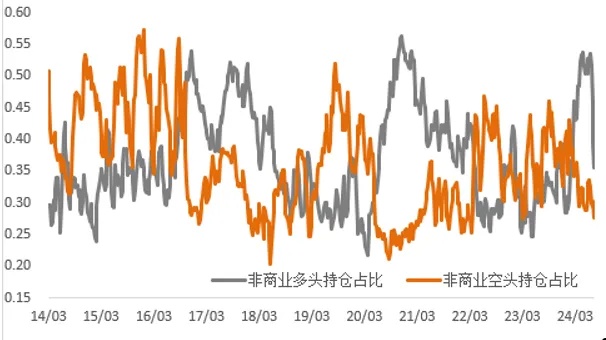
2. Precious metals market review
1. Precious metals market observation
COMEX precious metal prices diverged last week, with gold fluctuating at high levels and silver fluctuating downward. COMEX gold and silver operating in the range of US $2,403-2,500/oz and US $26.5-28.8/oz. The "Black Monday" triggered by the reversal of carry trade caused precious metal prices to fluctuate sharply. In the first half of the week, affected by the possible liquidity crisis after the Japanese rate hike, the price of gold dropped significantly. Since then, due to the US service industry PMI and initial jobless claims The performance data was better than expected, and the Bank of Japan turned dovish, the price of gold stabilized and rebounded.
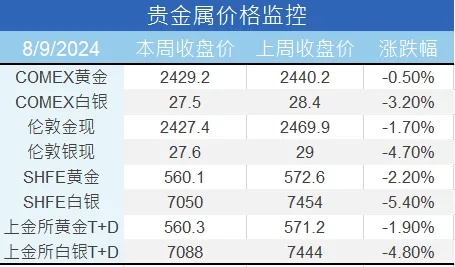
2. Price comparison and volatility
Last week, silver fell stronger than gold, and the gold-silver ratio still fluctuated upward; The decline of gold was weaker than that of copper, and the ratio of gold to copper fluctuated upward; Crude oil prices rebounded after falling compared with the previous period, and the gold-oil ratio fluctuated downward.
Figure 2: COMEX Gold/COMEX Silver
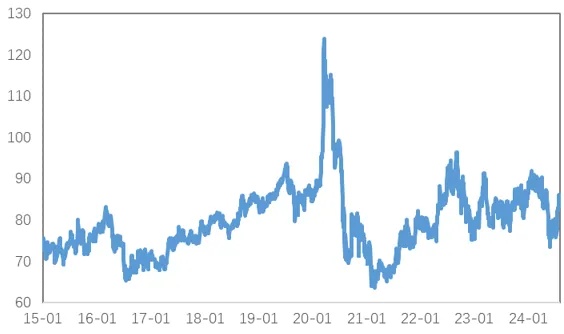
Gold VIX gradually fell back, market panic weakened, and safe-haven demand cooled down
Figure 3: Gold volatility
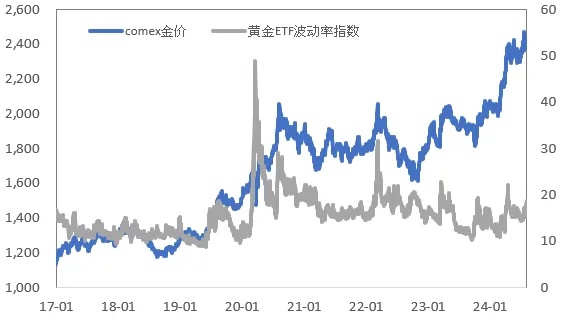
Recently, the impact of the RMB exchange rate has weakened compared with the previous period, and the internal and external price difference between gold and silver rebounded last week; The internal and external price ratio between gold and silver has increased.
Figure 4: Inside and outside price spreads of precious metals
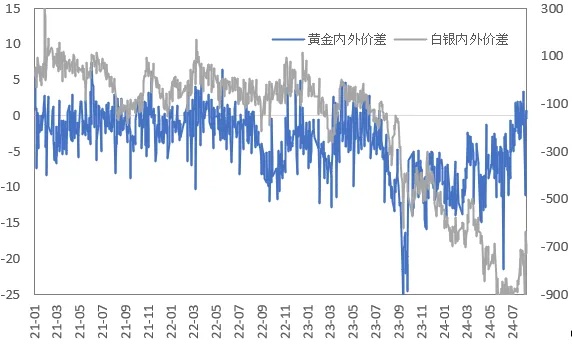
Market outlook
At present, the destocking situation of domestic refined copper inventories is acceptable, and downstream consumption has recovered significantly after the price fell. From a domestic perspective alone, although there has been no significant improvement at the macro level, the focus of market pricing is not on the domestic macro level.
Strength or weakness. In the future, we believe that the improvement of domestic consumption can still provide lower support for copper prices, which will either stabilize copper prices when overseas macro shocks weaken, or restrain the extent of domestic price corrections when shocks increase.
There is no signal of confirmation of recession in the U.S. economy for the time being. Under the premise that the liquidity crisis has not occurred, the expectation of interest rate cuts and safe-haven demand still support the strong operation of precious metal prices. However, the current overall price of gold is at a historical high, and another upward breakthrough still requires new drive. Pay attention to the impact of this week's U.S. CPI and retail sales data.
$E-mini Nasdaq 100 - main 2409(NQmain)$ $E-mini S&P 500 - main 2409(ESmain)$ $E-mini Dow Jones - main 2409(YMmain)$ $Gold - main 2412(GCmain)$ $Silver - main 2409(SImain)$
Comments